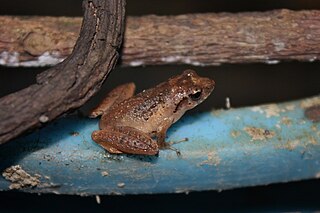
Romer's tree frog is a species of frog native to Hong Kong and a small portion of Guangxi, China. With an average snout-vent length of 1.5 – 2.5 cm, it is the smallest amphibian recorded in the territory. Despite its common name, it belongs to the family Rhacophoridae, instead of the Hylidae.
The Chiala mountain salamander is a species of salamander in the family Hynobiidae endemic to China and known from northwestern Sichuan, northeastern Tibet, and southeastern Gansu. Its validity as a species distinct from Batrachuperus tibetanus has been controversial. It is named after Karl Patterson Schmidt, American herpetologist.
Leptobrachella oshanensis, also known as the Oshan metacarpal-tubercled toad or pigmy crawl frog, is a frog species in the family Megophryidae. It is endemic to southern–central China (Guizhou, Hubei, Gansu, and Sichuan provinces as well as the municipality of Chongqing). Its type locality is Mount Emei (Chinese: 峨嵋山; pinyin: Éméi Shān; Wade–Giles: O2-mei2 Shan1). The same mountain has given the species its name. It has also been reported from Thailand and Laos but these are now considered to represent Leptobrachella minimus.
Oreolalax liangbeiensis is a species of amphibian in the family Megophryidae endemic to China: it is only known from the vicinity of its type locality, Puxiong (普雄镇) in Yuexi County, Sichuan, where it is known only from a single stream. Its natural habitats are subtropical moist montane forests and rivers. It is threatened by habitat loss.
Oreolalax pingii is a species of amphibian in the family Megophryidae. It is endemic to south-western China where it is restricted to the Daliang and Hengduan Mountains in Sichuan and Yunnan. Its natural habitats are subtropical moist montane forests, moist shrubland, and rivers. It is threatened by habitat loss.
Oreolalax puxiongensis is a species of amphibian in the family Megophryidae. It is endemic to China where it is only known from two locations in Yuexi County, Sichuan, including Puxiong (普雄镇), its type locality. It inhabits marshes, pools, small streams and the surrounding subtropical forest. It is threatened by habitat loss.
Scutiger brevipes is a species of amphibian in the family Megophryidae. It is endemic to China as it is only known from its type locality in Dawu County, Sichuan. It is sometimes considered to be a synonym of Scutiger glandulatus. Its lives in small forest streams and in spring-fed alpine streams.
The great piebald horned toad, or giant spadefoot toad, is a species of frog in the family Megophryidae, endemic to China. It is known only from Jingdong Yi Autonomous County and Yongde County in southwestern Yunnan. Its natural habitats are subtropical or tropical moist montane forests and rivers. It is threatened by habitat loss.
The Nankiang horned toad is a species of frog in the family Megophryidae. It is endemic to northern Sichuan and southern Gansu, China.
Nanorana parkeri is a species of frogs in the family Dicroglossidae. It is found in Tibet (China) and in Nepal, but it is expected to be found also in Bhutan and parts of India. It is the second amphibian, and the first Neobatrachian, to have its whole genome published.

Quasipaa exilispinosa is a species of frog in the family Dicroglossidae. It is known under many common names, including Hong Kong spiny frog, common spiny frog, lesser spiny frog, little spiny frog, and Hong Kong paa frog. It has a patchy distribution in southern China including Hong Kong. Its natural habitats are subtropical hill streams in forests or shrublands, and sometimes also seepages, stream-fed marshes, and forests. It is threatened by over-collecting for human consumption and by habitat loss.
Quasipaa jiulongensis is a species of frog in the family Dicroglossidae. It is endemic to eastern China and only known from the mountains of southwestern Zhejiang and adjacent Fujian above 800 m (2,600 ft) elevation. Its natural habitats are hill streams. It is threatened by habitat loss due to both logging and infrastructure development as well as by collection for food.
Odorrana anlungensis is a species of frog in the family Ranidae that is endemic to China: it is only known from its type locality, Mount Longtou in Anlong County, Guizhou. Its common name is Lungtou frog or Anlung odorous frog. Little is known about this species found in shaded hill streams 2-3m wide in forested areas.
Odorrana kuangwuensis is a species of frog in the family Ranidae that is endemic to China. It is found in northeastern Sichuan and northwestern Hubei. Its name refers to the type locality, Mount Guangwu in Nanjiang County, northern Sichuan.
Liuixalus ocellatus is a species of frog in the family Rhacophoridae. It is endemic to Hainan Island, China.

Liuixalus is a small genus of rhacophorid frogs that are distributed in southern China. Some species now in Romerus were originally placed in Philautus. It is thought to be the most basal genus in the Rhacophorinae.
Zhao Ermi was a Chinese herpetologist, born in Chengdu. His ancestors were Manchu Bannerman of Irgen Gioro clan who were stationed in Chengdu during Qing dynasty. He studied biology at West China Union University, under the tutelage of Liu Chengzhao. He was elected a member of the Chinese Academy of Sciences in 2001. He died at West China Medical Center of Sichuan University on 24 December 2016.
AmphibiaWeb is an American non-profit website that provides information about amphibians. It is run by a group of universities working with the California Academy of Sciences: San Francisco State University, the University of California at Berkeley, University of Florida at Gainesville, and University of Texas at Austin.
Liuixalus calcarius, the limestone small tree frog, is a species of frog in the family Rhacophoridae. It is endemic to Vietnam, where it was found in Hai Phong Province. It lives in tropical primary forest habitats rich in karst rock.
Liuixalus shiwandashan is a species of frog in the family Rhacophoridae. It is endemic to China. It has been observed in exactly one place: Mount Shiwanda in Guanxi Province, 937 meters above sea level.


